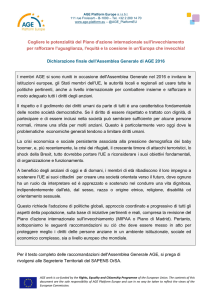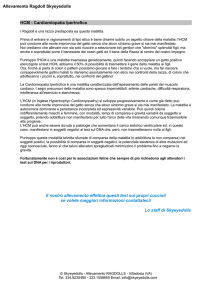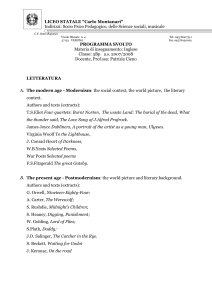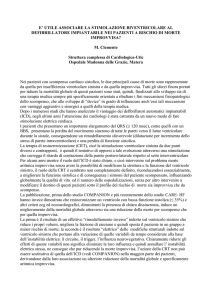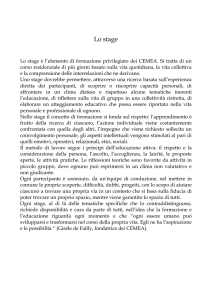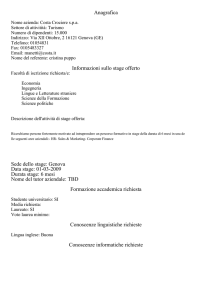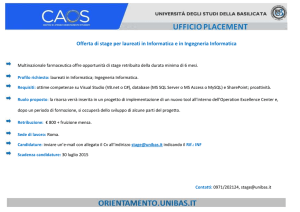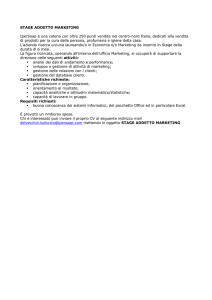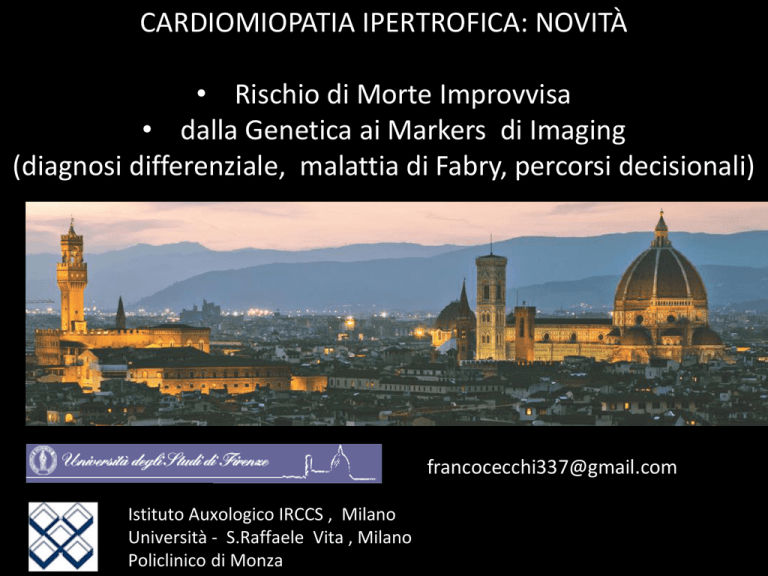
CARDIOMIOPATIA IPERTROFICA: NOVITÀ
• Rischio di Morte Improvvisa
• dalla Genetica ai Markers di Imaging
(diagnosi differenziale, malattia di Fabry, percorsi decisionali)
[email protected]
Istituto Auxologico IRCCS , Milano
Università - S.Raffaele Vita , Milano
Policlinico di Monza
HCM is a global now treatable disease
(prevalence : 2 per 1000)
50 countries….all continents
Courtesy of Maron B, mod.
1. Diagnosi e diagnosi differenziale
(Segni clinici, ECG, ECO, test genetici, screening familiare)
2. Valutazione e trattamento dell’ostruzione VS ± VDx
(Tratto d’efflusso, medioventricolare)
3. Gestione clinica dello scompenso cardiaco
4. Valutazione del rischio individuale di morte improvvisa
5. Prevenzione della morte improvvisa
(Terapia medica e/o chirurgica, indicazione ad ICD o S-ICD)
6. Altro (Follow up, Stile di vita , gravidanza , sport , etc)
Negli adolescenti ed adulti con spessore > 15 mm (CMI)
la valutazione clinica dovrebbe comprendere (classe I):
•
•
•
•
•
•
•
storia clinica e familiare,
Ecocolordoppler TT (± Eco da sforzo)
ECG dinamico 48 ore
RMN cardiaca con mdc
Test da sforzo (cardiopolmonare , se possibile)
Analisi genetica (12 geni: 8 sarcomerici + GLA, TTR, PRKAG2, LAMP2)
Screening familiari I grado
CMI: una miriade di anomalie da valutare
Spessori di parete
Tralci fibromuscolari
Muscoli papillari
anomali
Dimensioni cavità e
funzione sistolica e diastolica VS (e Vdx)
↓ TEVS
↑ Atrio sinistro
↑ Lembi Mitralici
Anello mitralico
SAM
L’importanza del MULTIIMAGING
nella diagnosi e valutazione del paziente
Ostruzione medioventricolare + aneurismi apicali (~5-10%)
ECOCARDIOGRAM
STAGE II
STAGE III
STAGE I
(gene carriers GENO+ PHENO -)
STAGE IV
Diagnosi differenziale
CMI sarcomerica e non sarcomerica
ECG
SEGNI & SINTOMI
Eco : Diagnosi Differenziale
MM 46 y male
His sister died suddenly 7 days ago at age 46. His mother died suddenly at age 52
His wife wants to know whether he has heart disease. He claims no symptoms. FC I
Abnormal ECG
ECHO LVH EF 44%
FAMILIAL TTR
AMYLOIDOSIS
HEART AND LIVER
TRANSPLANT
B MG, female, age 48, referred to ED for severe angina
•
•
•
•
No family history
At age 40 she was diagnosed with depression
At age 45 she started to complain of fatigue, palpitations and angina
No significant clinical signs; BP 120/80. Normal enzymes
B MG, female, age 48
•
No Coronary artery disease at coronary angio
• Unexplained LVH at echo (16 mm) LV EF 65%
• Diastolic dysfunction (TDI septal e’ 7 cm/sec) + Mild LA dilatation
Anderson Fabry HCM
α-Gal leucocyte activity 46.02 nmol/mg/h
GLA c.1 A>G (p.Met 1 Val)
Prevenzione morte improvvisa
RISK STRATIFICATION: RISK FACTORS
(ICD Guidelines for HCM AHA/ESC 2003 & AHA 2011)
RISK FACTOR
Sensitivity
Specificity
PPV
NPV
Family history of SD
42
79
28
88
Max LV thickness >30 mm
26
88
13
95
NSVT run > 120’
69
80
22
97
Abnormal pressure response
at exercise test age < 45
75
66
15
97
Syncope
29
83
25
86
Elliot P, W.McKenna, 2003
http://www.escardio.org/Guidelines-&-Education/
http://doc2do.com/hcm/webHCM.html
Valutazione del rischio
individuale di morte
improvvisa a 5 anni
(da fare alla prima visita,
poi ogni 1-2 anni oppure
se cambia la Classe funzionale)
Indicazione clinica ad ICD
Occorre tenere conto non solo del
rischio individuale a 5 anni, ma anche:
• Età del paziente
• Condizioni generali salute
• Fattori socio-economici
Class I
Class III
Class IIb
Class IIa
• Impatto psicologico
Additional Risk Factors for SCD risk stratification
• CHF, end stage /overt dysfunction disease (Stage III-IV EF < 50%)
• Abn BP response / Ventricular arrhythmias (NSVT /VF ) on Ex test
• Extent of LGE by CMR ( >15%)
• Bizarre ECG (pseudo STEMI pattern; low QRS voltages; QRS > 120)
• VE/VCO2 > 31 at cardiopulmonary test
Relation Between Sudden Death and
Extent of LGE in 1293 HCM Patients
Freedom from Sudden Death
Circulation 2014
Extent of LGE (> 15%)
is an additional risk factor in pts considered at low risk
LGE
LGE
L
G
E
LGE (-)
LGE < 10%
LGE 10-19%
p=0.02
LGE ≥20%
Follow-up (years)
PSEUDOSTEMI
PATTERN (17%)
Lifestyle and treatment options for SCD risk reduction
• Avoidance of competitive sports is recommended (Class I)
• AF ablation for AF with rapid ventricular response
• CAD treatment
• Myectomy reduces SD risk in HOCM pts
SURVIVAL FREE OF SUDDEN DEATH
(Rochester Mayo Clinic, versus Minneapolis + Florence)
Ommen S et al,
JACC 2005
CHOICE BETWEEN
STANDARD VERSUS
SUBCUTANEOUS ICD (S-ICD)
S-ICD may :
• avoid lead fracture and reduce sepsis management
• reduce inappropriate discharges due to SV arrhythmias
• improve LONG TERM RISK/BENEFIT RATIO + QOL
• increase acceptance by children and adolescents
S-ICD is not recommended when pacing is required
High Risk HCM patients
Favour Transvenous ICD
Favour S-ICD
+
Young Age
-
-
Atrial Fibrillation
+
+
Prior Lead Related Complication
-
-
Indication for Pacing
+
-
Sustained VT amenable to ATP
+
-
Planned Myectomy/Alcohol ablation
+
+/-
QRS/T< 1.36
+/-
-
TWIs in more than two leads
+
Thanks !!
[email protected]
Istituto Auxologico IRCCS , Milano
Università - S.Raffaele Vita , Milano
Policlinico di Monza

